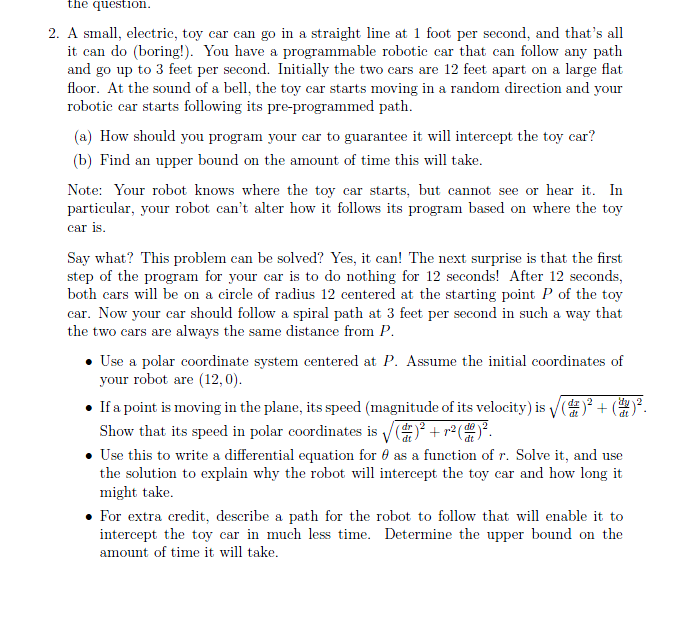
A small, electric, toy car can go in a straight line at 1 foot per second, and that's all it can do (boring!). You have a programmable robotic ear that can follow any path and go up to 3 feet per second. Initially the two cars are 12 feet apart on a large flat floor. At the sound of a bell, the toy car starts moving in a random direction and your robotic car starts following its pre-programmed path. (a) How should you program your car to guarantee it will intercept the toy car? (b) Find an upper bound on the amount of time this will take. Say what? This problem can be solved? Yes, it can! The next surprise is that, the first step of the program for your car is to do nothing for 12 seconds! After 12 seconds, both cars will be on a circle of radius 12 centered at the starting point P of the toy car. Now your car should follow a spiral path at 3 feet per second in such a way that the two cars are always the same distance from P. Use a polar coordinate system centered at P. Assume the initial coordinates of your robot are (12, 0). If a point is moving in the plane, its speed (magnitude of its velocity) is Squareroot (dx/dt)^2 + (dy/dt)^2. Show that its speed in polar coordinates is Squareroot (dr/dt)^2 + r^2 (d theta/dt)^2. Use this to write a differential equation for theta as a function of r. Solve it, and use the solution to explain why the robot will intercept the toy car and how long it might take. For extra credit, describe a path for the robot to follow that will enable it to intercept the toy car in much less time. Determine the upper bound on the amount of time it will take. A small, electric, toy car can go in a straight line at 1 foot per second, and that's all it can do (boring!). You have a programmable robotic ear that can follow any path and go up to 3 feet per second. Initially the two cars are 12 feet apart on a large flat floor. At the sound of a bell, the toy car starts moving in a random direction and your robotic car starts following its pre-programmed path. (a) How should you program your car to guarantee it will intercept the toy car? (b) Find an upper bound on the amount of time this will take. Say what? This problem can be solved? Yes, it can! The next surprise is that, the first step of the program for your car is to do nothing for 12 seconds! After 12 seconds, both cars will be on a circle of radius 12 centered at the starting point P of the toy car. Now your car should follow a spiral path at 3 feet per second in such a way that the two cars are always the same distance from P. Use a polar coordinate system centered at P. Assume the initial coordinates of your robot are (12, 0). If a point is moving in the plane, its speed (magnitude of its velocity) is Squareroot (dx/dt)^2 + (dy/dt)^2. Show that its speed in polar coordinates is Squareroot (dr/dt)^2 + r^2 (d theta/dt)^2. Use this to write a differential equation for theta as a function of r. Solve it, and use the solution to explain why the robot will intercept the toy car and how long it might take. For extra credit, describe a path for the robot to follow that will enable it to intercept the toy car in much less time. Determine the upper bound on the amount of time it will take







